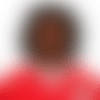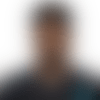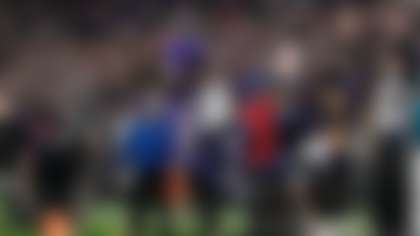One of my favorite offseason tasks is to scour every NFL roster and identify the most underappreciated player on each team using my context-based models. In the fast-paced NFL season, it's easy to focus on superstars or skill-position players who help us win in fantasy football, but one of the most useful applications of analytics is to view every game from the previous campaign through the lens of a total-contribution metric, to see where teams earned an edge that perhaps didn't get as much attention as it should have during the season.
With that in mind, here's how I came up with my list of the most underappreciated players ...
First, I calculated and then ranked each player's season-long contribution metric by team (win share). To sum it up without getting overly technical, contribution metric, or win share, measures each player's production during a season, in this case, the 2021 campaign. The metric encompasses a value for every snap by each player and reveals each player's contribution to the team's overall win total.
After making those calculations, I factored in each player's salary by position (contract data via Over The Cap) to add some context around who was being "underappreciated." I always try to give priority to players who do not switch teams this offseason (since it's harder to be underappreciated by a team you haven't played for yet), but this season that was significantly harder due to tons of free agent movement. (As for players on rookie contracts, while those are restricted by draft slot and will thus inherently rank lower than many veterans who have had a chance to negotiate a new deal, that doesn't mean they should be disqualified from consideration, given that they can still seriously outperform their compensation.) Then I weighted players drafted in Round 2 or later who have been to no more than two Pro Bowls. That said, the most critical component to this method is contribution metric.
After revealing the AFC selections on Wednesday, I'm here to provide one player from each NFC team that my model flagged as being underappreciated.
NOTE: Players are listed with the age they will be as of Sept. 8, when the 2022 NFL season is set to kick off.

APY: $2.5 million (81st among edge rushers).
With Chandler Jones signing in Las Vegas this offseason, Golden will be asked to play an even bigger role than he did last season, when he led Arizona in sacks (12) and hurries (25). Golden's pressure rate dipped from 17.8 in 2020 to 11.5 in 2021, but that was partly related to how often the Cardinals blitzed -- and how often they stuck to blitzing even when it wasn't working. Arizona blitzed at the third-highest rate last season (35.1) but allowed the most TDs in the NFL when blitzing (18).

APY: $3.576 million (rookie contract; 54th among cornerbacks).
I am breaking my no first-rounders rule here, but I think it’s warranted as Terrell's improvement in Year 2 was outstanding. PFF awarded Terrell with an 85.6 coverage grade in 2021, which ranked second among corners … only to Jalen Ramsey. Terrell's 43.9 completion percentage allowed in coverage was the lowest among CBs and his 47.5 passer rating allowed in coverage ranked third, per PFF (min. 50 targets). To give you an idea of his defensive efficiency, he allowed just 3.0 yards per target and 0.37 yards per coverage snap, both the lowest among NFL corners.

APY: $1.310 million (rookie contract; 70th among safeties).
Chinn’s positional versatility creates the type of middle-of-the-field problems that QBs -- especially younger ones who didn't face a variety of defenses in college -- have a hard time solving. Among DBs, Chinn ranked ninth in tackles (106, leading the Panthers), fourth in stops (47) and tied for seventh in QB pressures (8) in 2021.

APY: $1.004 million (rookie contract; 92nd among running backs).
I wish the Bears had addressed their O-line in a way I better understood as an outsider this offseason. After finishing the 2021 season with PFF's 22nd-ranked unit, Chicago let starters James Daniels and Jason Peters walk, replacing them with journeymen Julie'n Davenport and Dakota Dozier. I will be watching this situation closely to help forecast Montgomery's fantasy value. However, his real-world value is in part shown by computer vision metrics that indicate how much contact a back deals with. Not only was Montgomery contacted before getting to top speed at the third-highest rate last season, but he also faced multiple hits on the fifth-highest percentage of rushes and runs after the catch. And yet, he managed to haul in 82.4 percent of the passes thrown to him in 2021 (with a catch rate of 78.6 percent for his career). In other words, if the O-line can step up, Montgomery could soar.

APY: $797,582 (rookie contract; 174th among running backs).
Pollard’s 6.4 yards per rush outside the tackles in 2021 ranked second among backs with at least 50 attempts, per Next Gen Stats. His success as Dallas' No. 2 back helped earn him PFF's second-highest grade (90.3) among all RBs. Given questions along the O-line, there is a strong and logical case to be made for Dallas to feature more plays with both Pollard and Ezekiel Elliott on the field.

APY: $1.19 million (rookie contract; 72nd among guards).
The left guard earned a run-blocking grade of 76.4 from PFF last season (ranking 11th of 76 guards). The grade awarded to the Lions' O-line as a whole last season marked them as average (71.4, ranked 16th). Computer vision shows that Jackson's run blocking improved significantly over the course of the season while his pass blocking was drastically better when the Lions were able to use more balanced play-calling (not just the pass).

APY: $9 million (17th among safeties).
A big reason why the Packers are my model’s second-most likely NFC team to earn a trip to Super Bowl LVII is because of their defense. One football strategy that has been particularly impactful over the past two seasons is the effective use of two-safety shells (aka zone). When I talk to coaches about this, they believe it’s in large part due to how colleges do not play zone, or the types of zone that NFL teams do, so it can give the defense an edge. The Packers clearly think the scheme offers them an advantage, as they used two-safety shells on 67.4 percent of snaps last season (third-highest rate). Amos, a sure-tackler who earned PFF's 13th-best overall grade at the position (74.7), is fundamental to making that strategy work. Computer vision shows that in those zone looks, his passer rating allowed decreases by more than 15 points.

APY: $1.543 million (rookie contract; 47th among running backs).
Akers played in only one regular-season game during the 2021 campaign after his extremely speedy Achilles recovery (he tore it prior to the start of training camp). However, many data points, including an impressive rookie campaign, reveal his true value. Last season without Akers, L.A. was one of just three teams that had zero snaps with multiple running backs on the field. Also, they used empty backfields at the highest rate of any team in the NFL (19 percent of snaps), while using play-action at one of the lowest rates (23.4 percent, ranking 22nd). Sure, they still won the Super Bowl with that approach. But they should be that much more dangerous with Akers back in the fold. His availability creates more options for Sean McVay and also helps the transition to a new O-line configuration with Andrew Whitworth’s retirement.

APY: $6.5 million (32nd among interior defensive linemen).
My favorite computer vision stat on Phillips is the improvement he made after Week 9. His win share literally doubled from 0.38 to 0.77 at that turning point. His lateral movement on run stops was a big reason for his added value, as he kept his center of gravity low and feet aligned on 51.4 percent more snaps after Week 9. While Phillips' APY has him within the top 32 interior linemen, his 8.7 pressure rate last year was good enough to place him among the top 15 players at his position, per NGS.

APY: $1.421 million (rookie contract; 70th among linebackers).
Werner’s 8.3 stop percentage was the highest on the Saints last season, and his 62 tackles ranked 14th among rookie defenders, per NGS. The second-year pro played a big part in New Orleans’ defense allowing the lowest yards per rush when using a stacked box (1.6) and the fewest total rushing yards over expected (-208) in the NFL last year. Working with Demario Davis (a former pick in this exercise) is a very big advantage for Werner; expect the duo to continue to pose problems for opposing offenses.

APY: $2.098 million (rookie contract; 49th among safeties).
McKinney earned PFF's 12th-best coverage grade (78.4) among 113 qualifying safeties in 2021. Computer vision shows that when the Giants deployed man concepts, he was at his best, decreasing opposing passer ratings by an average of 22.2 points. McKinney, who led the team in interceptions last season (5), improved over the course of the campaign, and it stands to reason that he'll be asked to do even more in Year 3, especially given the departure of James Bradberry.

APY: $7.25 million (31st among cornerbacks).
Since entering the League in 2016, Bradberry has had at least 10 passes defensed in each season, the most such seasons by any player over that period. In fact, the veteran defender paces the NFL with 62 passes defensed since 2018. Last season his 15 forced incompletions tied for fourth most in the NFL. With all of the splashy free agent signings and trades we've seen this offseason -- including the Eagles' huge draft-day trade for A.J. Brown -- Bradberry’s intra-division move hasn't received quite as much buzz. But the forecasted production from the Eagles' secondary increased with his acquisition, leading Philly to now have a 0.5-win advantage over Dallas in the NFC East this season (was 0.2 before the signing).

APY: $13.5 million (14th among cornerbacks).
San Francisco's free agent pickup boasts an NFL-best 46.9 completion percentage allowed in coverage since 2019, per NGS (min. 150 targets). He also had only one penalty called against him last season with Kansas City. Not surprising then that the Niners, who ranked 29th in completion percentage allowed (68.2) and whose DBs were the most penalized in the league last season, pursued the 26-year-old this offseason.

APY: $1.147 million (rookie contract; 133rd among receivers).
As soon as this article publishes, the Seahawks can go ahead and show their appreciation for this man. I can’t believe he fits my criteria, but the 2019 second-rounder currently has only one Pro Bowl nod so far. Metcalf has become one of the NFL's most dominant perimeter threats, racking up the third-most receiving yards when aligned wide (2,757) since he entered the league, per NGS. In fact, over the past three seasons he leads the league in TDs of 10-plus air yards (20) and ranks second in go route TDs (11).

APY: $10 million (32nd among receivers).
Gage led all Falcons receivers in receptions (66), receiving yards (770) and receiving TDs (4) in 2021. Zooming in on Weeks 13-18, Gage's 500 receiving yards were the seventh most in the NFL. Maybe the Bucs signed him in small part due to his breakout performance against them in Week 13, when he had career highs in receptions (11) and yards (130). Quietly, Gage has amassed at least 750 yards and four TDs in back-to-back seasons. Especially with questions around Chris Godwin’s health, Gage’s value is much larger than his average salary.

APY: $961,918 (rookie contract; 181st among receivers).
I personally believe that McLaurin is the most underrated receiver in the entire league. How has he not been to at least ONE Pro Bowl?! One of the game's best route runners, McLaurin earned the third most yards of separation on all routes run in 2021, per computer vision. (Remember, this doesn’t mean he was targeted in these instances … though, maybe he should have been). His ability to run the complete route tree has led to him compiling the fifth most yards on in-breaking routes (angle, in, cross, post, slant) and the 11th most on deep passes since entering the league.
Follow Cynthia Frelund on Twitter.




























